Q-Grader examination experience and examination form Coffee examination Notes
There are 8 major items and 20 subjects in the Q-Grader examination.
The first major item (4 subjects) take the test together for every 2 subjects, limited time is 1 hour.
The second largest item (1 subject) the grading time of raw beans is limited to 1 hour.
The third major item (2 subjects) grading of cooked beans
The fourth major item (1 subject) organic acids are limited to 1 hour.
The fifth item (3 subjects) sensory skills examination is limited to 1 hour
The sixth item (4 subjects) the triangular cup test is limited to 45 minutes for each subject.
The seventh item (4 subjects) Cup test scores are limited to 1 hour for each subject.
The written examination for the theoretical questions of item 8 (1 subject) is limited to 1 hour.
How to pass the Q-Grader exam smoothly? today, Chongqing Brista Coffee training School will come to share the Q-Grader test experience and test form with friends.
The first major item is the incense bottle.
A total of 4 subjects, each 2 subjects together, limited time 1 hour
1. Enzyme reaction (9 bottles)
two。 Caramelization reaction (9 bottles)
3. Dry distillation reaction (9 bottles)
4. Defective smell (9 bottles)
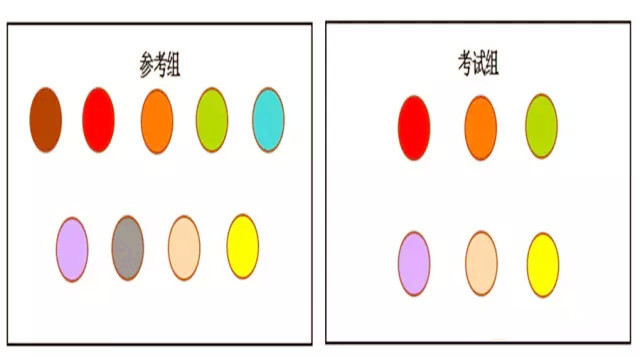
Examination form: put 9 bottles of incense bottles of this group on one side as a reference group, and 6 bottles on the other side, the bottle body is covered with duct tape.
Examination environment: red light classroom.
The 9 scent bottles cover the smell of 6 scent bottles. First of all, you need to rely on the reference group to determine the number of the 6 scent bottles (each bottle has its own number, the reference group has no cover, the smell is the same, you can fill in the number of the 6 scent bottles). Secondly, write down the smell of 3 of the scent bottles.
Experience in customs clearance:
During the practice, you need to remember the corresponding number of 36 scent bottles, and then you can fill in the odor names of 3 of the 6 bottles in the exam group through the numbers of the bottles in 9 reference groups.
For example, the smell of bottle An in the examination group is the same as that of bottle 7 in the reference group. Before, we knew that bottle 7 was "clove", so we can get the answer-bottle A corresponds to bottle 7, and bottle A smells like "clove".
Suggestions for preparing for the exam:
Find a set of perfume bottle practice before the exam, and divide it into four groups during the exam. to pick out a bottle casually with your eyes closed, you can accurately tell the number and smell of the bottle through your sense of smell.
The second largest item of raw bean grading
The time is limited to one hour.
Examination form: each person 3 boxes of raw beans, each box 350g, according to the SCAA standard to select defective beans, and distinguish which are first-class defects, which are second-class defects, calculate the score, summarize the score, and finally determine what grade this box of raw beans is (boutique grade or commercial grade).
Examination environment: regular environment.
Boutique grade: 0 first-class defects and 5 second-level defects.
There are both first-and second-level defects on a raw bean, which is calculated as a first-level defect.
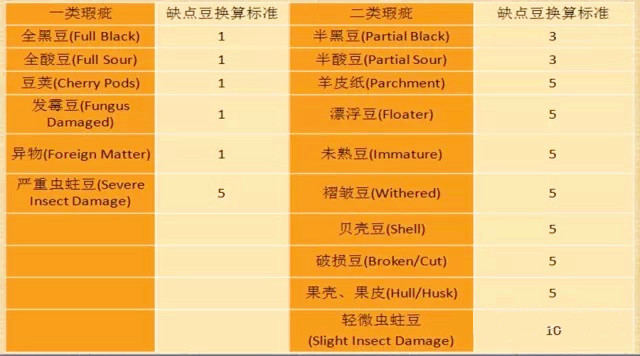
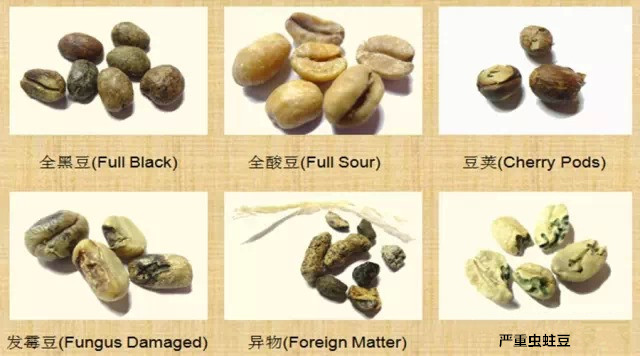
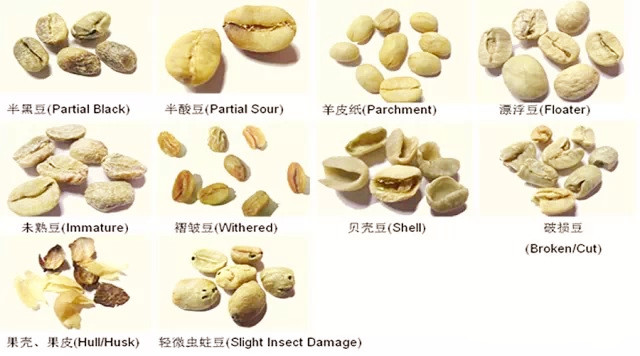
Exam notes:
It takes one hour to select three boxes of raw beans and to complete three reports on raw beans, which requires candidates to keep in mind the appearance of the above two types of defective beans and the corresponding scores.
The most likely thing to miss in the exam is a kind of defective foreign object, such as a fiber.
The third major item: classification of cooked beans.
There are two subjects-- cooked bean screening and sample identification.
The screening time for cooked beans is limited to 15 minutes.
The time limit for sample identification of cooked beans is 45 minutes
1. Ripe bean screening
Examination form: 100g cooked beans per person, pick out Baimu beans, count the number of Baimu beans, and grade this box of cooked beans according to this quantity (fine grade or Q-Grader grade or commercial grade).
Examination environment: regular environment.
The corresponding level of the number of white beans:
(1) 0: boutique coffee
(2) 1 Mel 3: Q grade coffee
(3) more than 3: commercial grade coffee
Experience in customs clearance:
Relatively speaking, this is relatively simple, 100g cooked beans spread out, the color of white beans is relatively light, basically clear at a glance.
two。 Identification of cooked bean samples
Test format: 5 cups of coffee, including 1 cup of slow roasting (baked) coffee, 1 cup of deep roasted coffee, 1 cup of light roasted coffee, 1 cup of normal roasted coffee and 1 cup of repetitive coffee (this cup may be the same as any of the first 4 cups). Through the cup test to determine what kind of coffee these five cups are.
Examination environment: red light classroom.
Experience in customs clearance:
Slow-roasted coffee is relatively light, with a hint of barley.
Deep-roasted coffee is easier to identify and will be relatively bitter.
Lightly roasted coffee is relatively sour, especially at low temperatures.
Normally roasted coffee is relatively saturated in flavor and acidity.
I feel that it will be easier to identify at a low temperature. This item has 45 minutes, so there is no need to worry.
The fourth largest organic acid
A time limit of 1 hour
Test form: a total of 8 groups of coffee, each group of 4 cups, candidates are required to pick out 2 of the 4 cups of coffee with acid, and then identify which kind of acid.
The organic acids in the exam include malic acid, citric acid, acetic acid and phosphoric acid.
Examination environment: red light classroom.
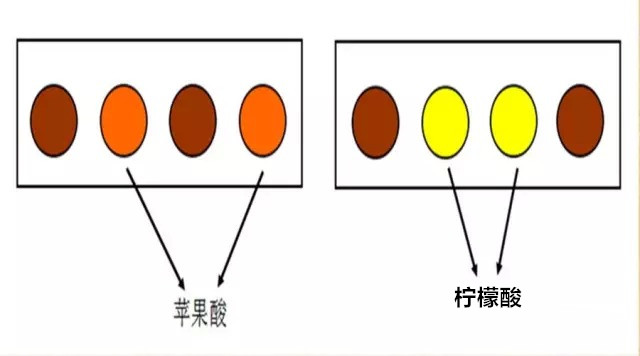
Experience in customs clearance:
Among malic acid, citric acid, phosphoric acid and acetic acid, acetic acid is the most volatile, so when you feel that the acidity of two cups of sour coffee in a group is extremely weak, it must be acetic acid. Phosphoric acid will give the tongue a certain sense of astringency, and the strength of the acid is weaker than malic acid and citric acid, and stronger than acetic acid. The identification of malic acid and citric acid depends on both sides of the tongue and the root of the tongue. What feels relatively sweet is malic acid, and the other is citric acid.
The fifth sensory skills test
A total of three subjects are limited to one hour, that is, the sour and sweet salt water exam.
Subject 1
Form of examination:
Each person has a total of 9 cups of white water, in which sour, sweet and salty flavors are added, each of which is divided into three different concentrations: weak, medium and strong. During the examination, the examinees were divided into three groups and provided to the examinees, the three concentrations of acid were divided into one group, the three concentrations of sweet were divided into one group, and the three concentrations of salt were divided into one group. after drinking, the examinees filled in the cup number after each flavor concentration.
Examination environment: general environment
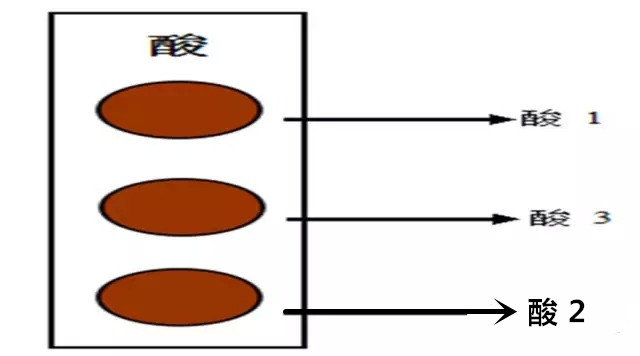
Subject 2
Form of examination:
Each person has a total of 9 cups of white water, and the above three flavors are also added, but they are not grouped separately, but the cups with three flavors and three concentrations are mixed together. After drinking, the examinees write down the taste and concentration corresponding to the cup number.
Examination environment: general environment
Subject 2 passes the standard
11 points per cup-6 points for "taste" type and 5 points for "taste" intensity
Out of 99 points, 79 points pass.
Subject 3
Form of examination:
Each person has a total of 8 cups of white water, and at least 2 flavors are added to each cup (8 cups, 4 cups add 3 flavors, and 4 cups add 2 flavors). The taste and concentration of each cup of water are different. after drinking, candidates should write down the taste and concentration of the cup number.
Examination environment: general environment
Subject 3 passes the standard
The type of "taste" in each cup accounts for 4 points, and the intensity of "taste" accounts for 2 points.
Out of 96 points, 68 points pass.
Experience in customs clearance:
1. Subject 1, because the three subjects are taken together, the time is limited to one hour, and the last level is the most difficult, so the first level needs to be completed as soon as possible to make time for later examinations.
two。 Subject 2, first taste all 9 cups, and then classify the sour, sweet and salty solutions, that is, sour weak, sour, sour strong together, sweet weak, sweet medium, sweet strong together, salty weak, salty medium, and salty strong together, and then, like the first level, identify their concentration by comparison.
3. Subject 3, the last level is known as "Devil Water".
First of all, emphasize: sour + sweet-improve sweetness; sour + salty-reduce sour taste; salty + sweet-there will be no change in taste concentration. Second, the solution can be refilled after drinking, so if you really can't taste it, drink it in big gulps, and the effect will be more obvious. Finally, when you taste it, you must be calm and feel the taste with your tongue carefully. Most of them can be distinguished.
The sixth item triangle cup test
A total of 4 subjects, each subject is limited to 45 minutes.
Form of examination:
There are 6 groups, each with 3 cups of coffee, one cup has a different flavor from the other two cups, and a different cup number needs to be written on the answer sheet.
This examination requires that we start from smelling the dry fragrance of coffee powder. Water injection, smelling wet fragrance, broken residue, salvage residue and cup test are all completed by candidates, so the test can be judged according to their own sense of smell and taste.
Examination environment: red light classroom
Experience in customs clearance:
Through the smell of dry incense, a preliminary judgment of the answer
Smell the damp incense, confirm or change the answer
High temperature cup time measurement to confirm the answer.
The answer is finally confirmed during the cryogenic cup test.
Everyone has a different period of time to identify the flavor accuracy, and some people will have a high identification accuracy when smelling dried incense, so they mainly rely on this link to identify, and some people will have a high identification accuracy when measuring a cryogenic cup, so wait until the temperature drops before determining the answer.
The seventh item cup test score
A total of 4 subjects, each subject is limited to 1 hour.
Form of examination:
A total of 6 groups, each with 5 cups, passed the cup test and filled in the SCAA cup table to score the coffee.
This examination requires that starting from grinding beans, the dry fragrance of coffee powder, water injection, wet fragrance, broken dregs, dregs and cup tests are all completed by candidates.
Examination environment: general environment
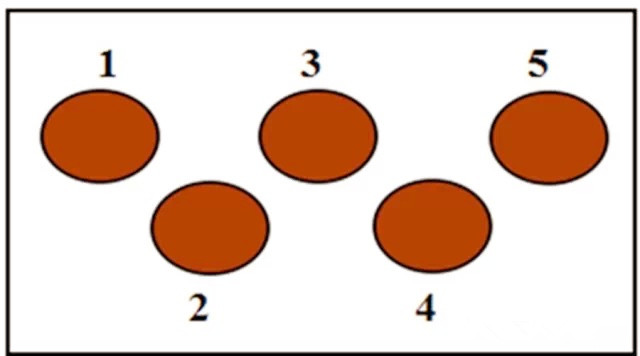
The written examination of the eighth theoretical question
100 multiple choice questions, 1 point each, 75 points passed. The time is limited to one hour.
The written test covers a wide range of subjects' knowledge accumulation and reserve of coffee, including cup testing knowledge, extraction knowledge, planting, processing, storage, roasting, producing areas and trade, etc.
Recommended for more exciting content:
Barista examination some summaries of the barista Qgrader examination
Some summaries of Qgrader examination for reference
Introduction about SCAA coffee cup tasting expert Q GRADER
Coffee Q-GRADER test materials some summary of the Q-GRADER exam
Important Notice :
前街咖啡 FrontStreet Coffee has moved to new addredd:
FrontStreet Coffee Address: 315,Donghua East Road,GuangZhou
Tel:020 38364473
- Prev
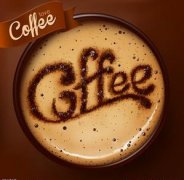
Japanese hand Coffee course and summarize the essence of Coffee path
Japanese coffee, has a very strong Craftsmanship (craftsman spirit), imagine the Japanese bow, tea, kendo, cuisine, are very ceremonial and exquisite, although not the so-called craftsman, but enough to reflect the connotation of the word Craftsmanship. Now, Japan can call its coffee culture Coffee Road! They give a cup of coffee the highest respect, which
- Next
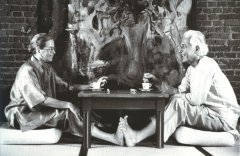
Taste the coffee and enjoy the coffee culture
People who understand coffee no longer regard coffee as a drink, know how to appreciate it, the more you know how to appreciate it, it is not only a kind of literature and art, but also a kind of art. The color of coffee is a kind of nostalgia, like the hourglass of time slowly under the curtain, stirring with a coffee stick, and like an old-fashioned video recorder broadcasting unforgettable images without sound. The smell of coffee is a dream, through the heat.
Related
- Beginners will see the "Coffee pull flower" guide!
- What is the difference between ice blog purified milk and ordinary milk coffee?
- Why is the Philippines the largest producer of crops in Liberia?
- For coffee extraction, should the fine powder be retained?
- How does extracted espresso fill pressed powder? How much strength does it take to press the powder?
- How to make jasmine cold extract coffee? Is the jasmine + latte good?
- Will this little toy really make the coffee taste better? How does Lily Drip affect coffee extraction?
- Will the action of slapping the filter cup also affect coffee extraction?
- What's the difference between powder-to-water ratio and powder-to-liquid ratio?
- What is the Ethiopian local species? What does it have to do with Heirloom native species?

